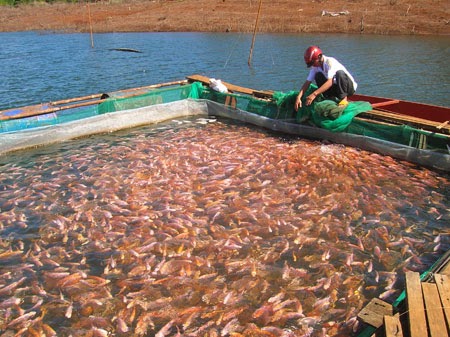Ministry constrains antibiotics abuse
 |
Accordingly, only certified antibiotics or those listed as permissible can be imported for the production of veterinary medicine in Vietnam. There are currently 57 antibiotics on this list. In addition, while applying for a licence, importers are required to report on the use of previous shipments and disclose further information, such as the identity and address of the sellers.
“The traders are not permitted to sell the antibiotic materials to establishments which are not licensed to produce veterinary medicines,” Dam Xuan Thanh, deputy director of the ministry’s Veterinary Department, told local media, adding that to fully prevent unauthorised antibiotics from reaching livestock, the regulations prohibit sales to veterinary medicine dealers or breeders and farmers.
The restrictions came amidst the increasing qualms about the quality of Vietnamese seafood exports.
Probably as the first serious steps to combat the overuse of antibiotics in sea animal breeding, the Veterinary Department has ceased handing out licenses to import the antibiotic Enrofloxacin and ordered six firms to suspend operations (terms of three to 12 months) for violating antibiotics trading regulations.
According to the Vietnam Association of Seafood Exporters and Producers (VASEP), in 2016 Vietnam’s seafood export was $7 billion, up 7.4 per cent. Of the amount, shrimp continued to make up the biggest portion of 44 per cent in terms of value, with $3.1 billion. Pangasius ranked second with $1.6 billion, while tuna contributed $500 million and octopus $440 million.
In 2017, the seafood production and export industry is going to face some challenges including high cost of production, as drought and salt water intrusion may cause a reduction in the yield of shrimp and increase risk of disease.
Traditional markets such as the US, EU, Australia and Japan are tightening criteria for seafood import in terms of origin, labour conditions, and food safety. The US has withdrawn from the TPP and may increase import tariff so VASEP expected Vietnam’s seafood export to the US to halve this year, while export to the EU and Japan is expected to be stable. China on the other hand, may increase its seafood import from Vietnam; and VASEP expected the figure at $1 billion.
| RELATED CONTENTS: | |
| Series of Vietnamese exporters fall prey to Canadian scammer company | |
| China could take lead in tra fish import | |
| Pact boosts Việt Nam-Russia trade: officials | |
What the stars mean:
★ Poor ★ ★ Promising ★★★ Good ★★★★ Very good ★★★★★ Exceptional
Latest News
More News
- Hanoi symposium highlights gender equality research and policy (December 03, 2025 | 12:00)
- Germany and Vietnam discuss development cooperation (December 02, 2025 | 20:39)
- Vietnam to limit raw rare earth exports (December 02, 2025 | 17:08)
- Japanese embassy marks 20 years of Japan-ASEAN bond market support (December 02, 2025 | 16:57)
- Roadmap unveiled to tighten vehicle emission standards (November 29, 2025 | 09:00)
- Technology and green finance emerge as twin pillars for Vietnam’s sustainable growth (November 28, 2025 | 10:52)
- Experts weigh in on Vietnam’s sustainability progress and future priorities (November 27, 2025 | 18:51)
- Green manufacturing insights and transformations: SABECO’s path to industry leadership (November 27, 2025 | 14:35)
- Siemens leads technology transformation towards sustainability in Vietnam (November 27, 2025 | 12:29)
- Hanoi workshop targets market access for women-owned firms (November 27, 2025 | 09:00)

















 Mobile Version
Mobile Version